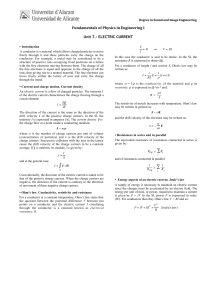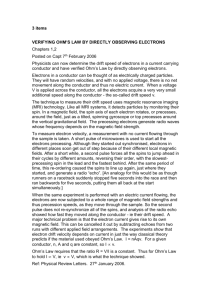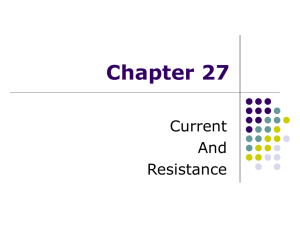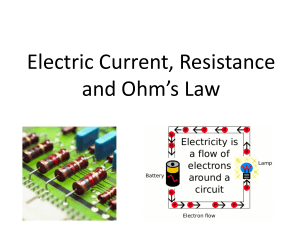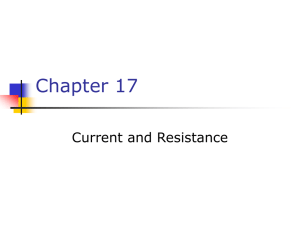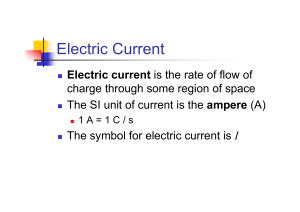Current and Resistance
advertisement
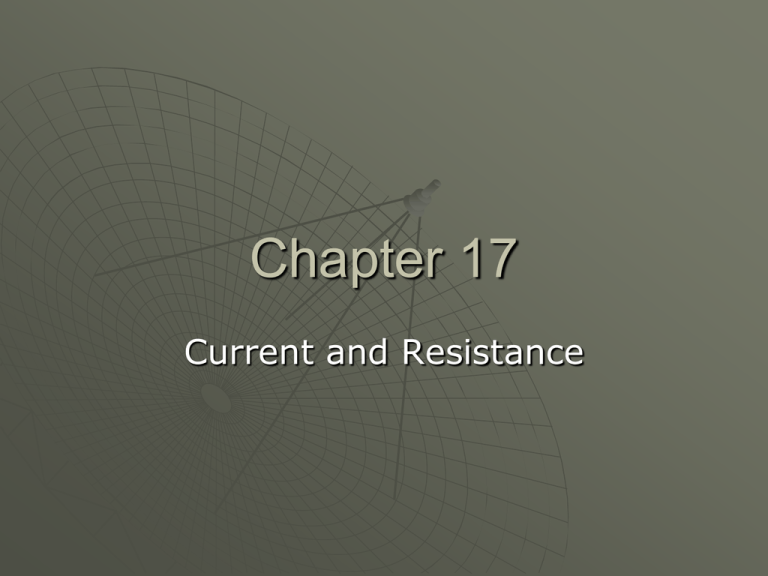
Chapter 17 Current and Resistance Current, Resistance, and Power Ch 17, Secs. 1–4, 6–7 (skip Sec. 5) General Physics Electric Current Whenever electric charges of like signs move, an electric current is said to exist The current is the rate at which the charge flows through this surface • Look at the charges flowing perpendicularly to a surface of area A Q I t The SI unit of current is Ampere (A) • 1 A = 1 C/s General Physics Electric Current, cont The direction of the current is the direction positive charge would flow • This is known as conventional current direction In a common conductor, such as copper, the current is due to the motion of the negatively charged electrons It is common to refer to a moving charge as a mobile charge carrier • A charge carrier can be positive or negative General Physics Current and Drift Speed Charged particles move through a conductor of crosssectional area A n is the number of charge carriers per unit volume (charge carrier density) n A Δx is the total number of charge carriers The total charge is the number of carriers times the charge per carrier, q • ΔQ = (n A Δx) q General Physics Current and Drift Speed, cont The drift speed, vd, is the speed at which the carriers move • vd = Δx/Δt Rewritten: ΔQ = (n A vd Δt) q So, current, I = ΔQ/Δt = nqvd A If the conductor is isolated, the electrons undergo random motion When an electric field is set up in the conductor, it creates an electric force on the electrons and hence a current General Physics Charge Carrier Motion in a Conductor The zig-zag black line represents the motion of charge carrier in a conductor • The net drift speed is small The sharp changes in direction are due to collisions The net motion of electrons is opposite the direction of the electric field Active Figure: Electron Drift in a Conductor General Physics Electrons in a Circuit The drift speed is much smaller than the average speed between collisions When a circuit is completed, the electric field travels with a speed close to the speed of light Although the drift speed is on the order of 10-4 m/s the effect of the electric field is felt on the order of 108 m/s General Physics Meters in a Circuit – Ammeter and Voltmeter An ammeter is used to measure current • In line with the bulb, all the charge passing through the bulb also must pass through the meter A voltmeter is used to measure voltage (potential difference) • Connects to the two ends of the bulb General Physics Resistance In a conductor, the voltage applied across the ends of the conductor is proportional to the current through the conductor The constant of proportionality is the resistance of the conductor V R I General Physics Resistance, cont Units of resistance are ohms (Ω) •1 Ω = 1 V / A Resistance in a circuit arises due to collisions between the electrons carrying the current with the fixed atoms inside the conductor General Physics Georg Simon Ohm 1787 – 1854 Formulated the concept of resistance Discovered the proportionality between current and voltages General Physics Ohm’s Law Experiments show that for many materials, including most metals, the resistance remains constant over a wide range of applied voltages or currents This statement has become known as Ohm’s Law • ΔV = I R Ohm’s Law is an empirical relationship that is valid only for certain materials • Materials that obey Ohm’s Law are said to be ohmic General Physics Ohm’s Law, cont An ohmic device The resistance is constant over a wide range of voltages The relationship between current and voltage is linear The slope is related to the resistance General Physics Resistivity The resistance of an ohmic conductor is proportional to its length, L, and inversely proportional to its cross-sectional area, A l R A • ρ is the constant of proportionality and is called the resistivity of the material • See table 17.1 General Physics Temperature Variation of Resistance For most metals, resistivity increases with increasing temperature • With a higher temperature, the metal’s constituent atoms vibrate with increasing amplitude • The electrons find it more difficult to pass through the atoms For most metals, resistivity increases roughly linearly with temperature over a limited temperature range General Physics Superconductors A class of materials and compounds whose resistances fall to virtually zero below a certain temperature, TC • TC is called the critical temperature The graph is the same as a normal metal above Once a current is set up in a superconductor, it persists without any applied voltage since R = 0 One application is superconducting magnets General Physics Electrical Energy and Power In a circuit, as a charge moves through the battery, the electrical potential energy of the system is increased by ΔQΔV • The chemical potential energy of the battery decreases by the same amount As the charge moves through a resistor, it loses this potential energy during collisions with atoms in the resistor • The temperature of the resistor will increase General Physics Electrical Energy and Power, cont The rate at which energy is supplied (by source) and lost (by resistance) is the power Q V I V t The SI unit of power is Watt (W) • 1 W = 1 VA From Ohm’s Law, alternate forms of power are V I R R 2 2 Active Figure: Ohm's Law and Electric Power General Physics Electrical Energy and Power, final The unit of energy used by electric companies is the kilowatt-hour • This is defined in terms of the unit of power and the amount of time it is supplied • 1 kWh = 3.60 x 106 J General Physics


